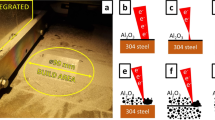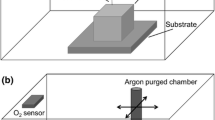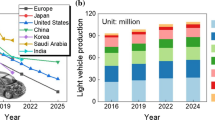This paper provides a review of aluminum oxide properties associated with its use, varieties of commercial products, methods for producing aluminum oxide in a disperse state, in the form of polycrystalline ceramics and single-crystal products, as well as chemical aspects of the related technological processes.
Similar content being viewed by others
Notes
A reference to aluminum oxide (Al2O3) in general often implies corundum (α-Al2O3), although in a stricter sense, Al2O3 includes all, even metastable modifications.
There is an alternative classification, according to which materials with εr > 7 (silicon nitride), including Al2O3, are placed in the high dielectric permittivity group.
There are also metastable aluminum orthosilicates Al2SiO5 (sillimanite, andalusite, and kyanite).
References
Springer handbook of condensed matter and materials data; ed. byW. Martienssen and H. Warlimont, Springer, Berlin, Ch. 3.2, 431 – 476 (2005).
F. Cardarelli, Materials handbook: a concise desktop reference; 2nd ed., Springer-Verlag, London, 600 – 609 (2008).
R. H. Doremus, Alumina-silica system, Handbook of ceramics and composites. Vol. 1: Synthesis and properties; ed. by N. P. Cheremisinoff, Marcel Dekker, New York, Basel, 23 – 34 (1990).
Ceramic and glass materials: structure, properties and processing; ed. by J. F. Shackelford and R. H. Doremus, Springer, New York (2008), 201 p.
D. Galusek, K. Ghillányová, Ceramic oxides, Ceramics science and technology. Vol. 2: Materials and properties; ed. by R. Riedel and I.-W. Chen, Wiley-VCH, Darmstadt, Ch. 1, 3 – 58 (2010).
AZoM, [Electronic resource], access mode: https://www.azom.com.
Reade, Mohs’ hardness (typical) of abrasives, [Electronic resource], access mode: http://www.reade.com/reade-resources/reference-educational/reade-reference-chart-particle-propertybriefings/32-mohs-hardness-of-abrasives.
CRC handbook of chemistry and physics; ed. byW. M. Haynes; 97th ed., CRC Press, Boca Raton, 12 – 48, 15 – 43 (2017).
C. Neusel, H. Jelitto, D. Schmidt, et al., Thickness-dependence of the breakdown strength: analysis of the dielectric and mechanical failure, J. Eur. Ceram. Soc., 35(1), 113 – 123 (2015).
P. Nanni, Synthesis of dielectric ceramic materials, P. Nanni, M. Viviani, and V. Buscaglia, Handbook of low and high dielectric constant materials and their applications; ed. by H. S. Nalwa, Academic Press, San Diego, 1, 9, 431 (1999).
S. Penn and N. Alford, Ceramic dielectrics for microwave applications, Handbook of low and high dielectric constant materials and their applications; ed. by H. S. Nalwa, Academic Press, San Diego, 2, Ch. 10, 496 (1999).
High thermal conductivity materials; ed. by S. L. Shinde and J. S. Goela, Springer, New York (2006), 271 p.
Ye. S. Lukin, N. A. Makarov, I. V. Dodonova, et al., New alumina-based ceramic materials, Ogneupory Tekhn. Keram., No. 7, 2 – 10 (2001).
Handbook of ceramic composites; ed. by N. P. Bansal, Kluwer Academic Publishers, Boston, Dordrecht, London (2005), 558 p.
K. Hirota, K. Yamamoto, K. Sasai, et al., Fabrication of dense ZrO2–Al2O3 composite ceramics by pulsed electric-current pressure sintering of neutralization coprecipitated powders, The Harris Science Review of Doshisha University, 58(2), 51 – 62 (2017).
M. Ilatovskaia, G. Savinykh, O. J. Fabrichnaya, Thermodynamic description of the Ti–Al–O system based on experimental data, Journal of Phase Equilibria and Diffusion, 38(3), 175 – 184 (2017).
D. A. Jerebtsov, G. G. Mikhailov, and S. V. Sverdina, Phase diagram of the system: Al2O3–ZrO2, Ceram. Int., 26(8), 821 – 823 (2000).
A. P. Garshin and S. M. Fedotova, Abrasive materials and tools: production technology, Polytech. Univ. Publishing, St. Petersburg (2008), 1009 p.
CoorsTek. Alumina overview, [Electronic resource], access mode: https://www.coorstek.com/english/solutions/materials/technical-ceramics/alumina.
Accuratus. Aluminum oxide, Al2O3 ceramic properties, [Electronic resource], access mode: http://accuratus.com/alumox.html.
GOST R ISO 6474-1–2014. Implants for surgery. Ceramic materials. Part 1. Ceramic materials based on high-purity alumina, Standartinform, Moscow (2015), 11 p.
GOST R ISO 6474-2–2014. Implants for surgery. Ceramic materials. Part 2. Composite materials based on high-purity alumina with zirconium reinforcement, Standartinform, Moscow (2015), 12 p.
MTI, [Electronic resource], access mode: http://www.mtixtl.com.
Tekhstroy. Abrasive and sandblasting materials based on aluminum oxides—electrocorundum and its varieties, [Electronic resource], access mode: http://www.teh-stroy.ru/st_elektrokorundavidy-modifikatsii-oksida-alyuminiya-al2o3-abrazivnogo-korunda.php.
I. Kh. Stratiyevskii, Abrasive processing: reference book, I. Kh. Stratiyevskii, V. G. Yuryev, and Yu. M. Zubarev, Mashinostroenie, Moscow, 7 (2010).
GOST 28818–90. Abrasive materials from electrocorundum. Specifications, Standards publishing house, Moscow (1991), 7 p.
GOST 3647–80. Abrasive materials. Granularity and grain composition. Control methods, IPK, Standards publishing house, Moscow (2004), 18 p.
GOST R 52381–2005. Abrasive materials. Granularity and grain composition of grinding powders. Control of grain structure, Standartinform, Moscow (2005), 11 p.
This study was performed within the scope of the state assignment No. 10.8003.2017/8.9 of the Ministry of Education and Science of the Russian Federation.
(To be continued)
Author information
Authors and Affiliations
Corresponding author
Additional information
Translated from Novye Ogneupory, No. 1, January, pp. 16 – 23, 2019.
Rights and permissions
About this article
Cite this article
Abyzov, A.M. Aluminum Oxide and Alumina Ceramics (review). Part 1. Properties of Al2O3 and Commercial Production of Dispersed Al2O3. Refract Ind Ceram 60, 24–32 (2019). https://doi.org/10.1007/s11148-019-00304-2
Received:
Published:
Issue Date:
DOI: https://doi.org/10.1007/s11148-019-00304-2




